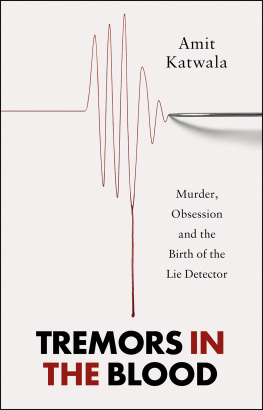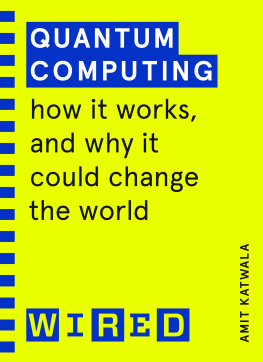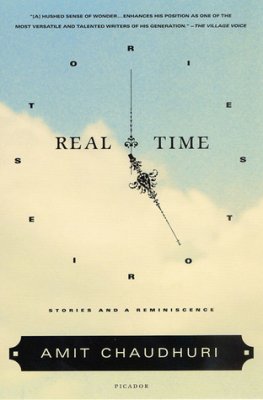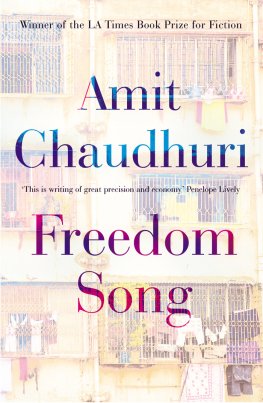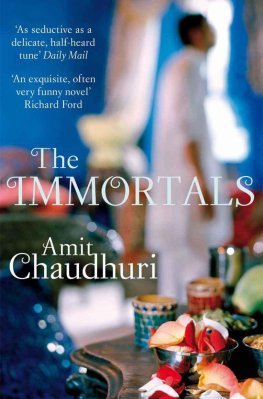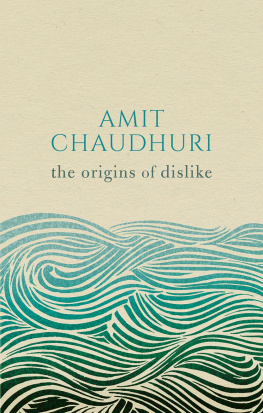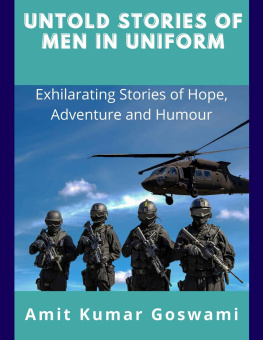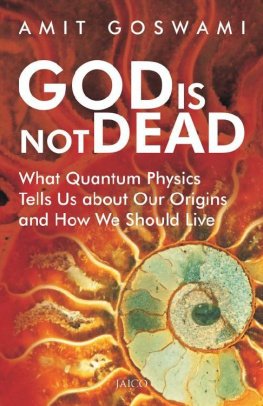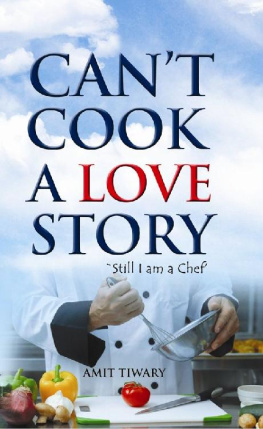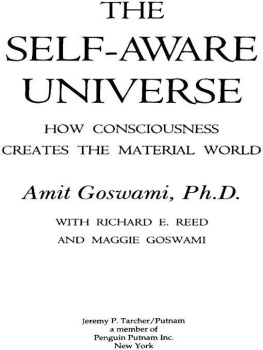Amit Katwala - Tremors in the Blood
Here you can read online Amit Katwala - Tremors in the Blood full text of the book (entire story) in english for free. Download pdf and epub, get meaning, cover and reviews about this ebook. year: 2022, publisher: HarperCollins Publishers, genre: Non-fiction. Description of the work, (preface) as well as reviews are available. Best literature library LitArk.com created for fans of good reading and offers a wide selection of genres:
Romance novel
Science fiction
Adventure
Detective
Science
History
Home and family
Prose
Art
Politics
Computer
Non-fiction
Religion
Business
Children
Humor
Choose a favorite category and find really read worthwhile books. Enjoy immersion in the world of imagination, feel the emotions of the characters or learn something new for yourself, make an fascinating discovery.
- Book:Tremors in the Blood
- Author:
- Publisher:HarperCollins Publishers
- Genre:
- Year:2022
- Rating:4 / 5
- Favourites:Add to favourites
- Your mark:
- 80
- 1
- 2
- 3
- 4
- 5
Tremors in the Blood: summary, description and annotation
We offer to read an annotation, description, summary or preface (depends on what the author of the book "Tremors in the Blood" wrote himself). If you haven't found the necessary information about the book — write in the comments, we will try to find it.
Tremors in the Blood — read online for free the complete book (whole text) full work
Below is the text of the book, divided by pages. System saving the place of the last page read, allows you to conveniently read the book "Tremors in the Blood" online for free, without having to search again every time where you left off. Put a bookmark, and you can go to the page where you finished reading at any time.
Font size:
Interval:
Bookmark:

Mudlark
HarperCollinsPublishers
1 London Bridge Street
London SE1 9GF
www.harpercollins.co.uk
HarperCollinsPublishers
1st Floor, Watermarque Building, Ringsend Road
Dublin 4, Ireland
First published by Mudlark 2022
FIRST EDITION
Text Amit Katwala 2022
Cover design by Steve Leard HarperCollinsPublishers Ltd 2022
Cover images Shutterstock.com
Chapter illustration: Shutterstock.com
A catalogue record of this book is available from the British Library
Amit Katwala asserts the moral right to be identified as the author of this work
All rights reserved under International and Pan-American Copyright Conventions. By payment of the required fees, you have been granted the nonexclusive, non-transferable right to access and read the text of this e-book on screen. No part of this text may be reproduced, transmitted, downloaded, decompiled, reverse engineered, or stored in or introduced into any information storage retrieval system, in any form or by any means, whether electronic or mechanical, now known or hereinafter invented, without the express written permission of HarperCollins e-books.
Find out about HarperCollins and the environment at www.harpercollins.co.uk/green
Source ISBN: 9780008434076
Ebook Edition May 2022 ISBN: 9780008434083
Version 2022-03-25
This ebook contains the following accessibility features which, if supported by your device, can be accessed via your ereader/accessibility settings:
- Change of font size and line height
- Change of background and font colours
- Change of font
- Change justification
- Text to speech
- Page numbers taken from the following print edition: ISBN 9780008434076
For Sara, my ground truth
Guilt carries fear always about with it; there is a tremor in the blood of a thief.
DANIEL DEFOE, 1730
This is the story of two murders and the machine that connects them: a near-mythical box with the power to sort truth from lies.
Everything youre about to read really happened, and the account that follows is based on historical sources: thousands of newspaper and magazine articles, private letters, diaries, academic journals, photographs, court documents, prison records, books, physical artefacts and interviews.
Anything between quotation marks comes from a written document or an interview all dialogue attributed to people was said or written, or reportedly said or written, by those in question.
Where different accounts disagree on the exact wording, Ive opted for clarity and concision. Where there are more significant disputes about what actually happened, Ive noted these in the main text or in the notes and references at the end.
But this isnt a history book. The development of the lie detector is more relevant than ever, not only because the polygraph endures, but because of what that reveals about our own attitudes to science and technology, and our relationship with the truth.
In their pursuit of justice, the men who invented the lie detector unleashed a power they couldnt control. In turbulent times, they turned to science for answers but it merely reflected their flaws and amplified their prejudice. They were in thrall to technology and buffeted by it they constructed false idols and fell at their feet.
This is a book about science and psychology, yes, but its also about people: their obsessions and rivalries, their dark impulses and violent passions. It is a true story.

(Shutterstock.com)
A yellow car sped north, down out of the mountains towards San Francisco. Its round headlights cut twin beams through the gathering mist. At the wheel, Henry Wilkens risked a glance in his rear-view mirror. They were definitely being followed.
It was the evening of Tuesday 30 May 1922 Decoration Day and the nation had come to a halt to remember its dead, and to decorate their graves. More than 100,000 Americans had perished in the Great War and in the city it had been a solemn, grey occasion. Soldiers laid wreaths for the fallen, the silence broken only by the clamour of gulls circling in the bay and the great foghorn of Alcatraz island booming in the distance.
But, for most people, the public holiday (today known as Memorial Day) was already morphing into a leisure opportunity. It was the era of flapper girls and prohibition, and San Francisco was finally getting its swing back after the devastation of the 1906 earthquake and fire.
Each morning, commuters in sharp suits and hats rode ferries across the bay from Oakland and Berkeley, and piled on to busy streetcars. At night, women in fur coats approached unmarked doors with whispered passwords, hair curled and coiffed into elaborate bobs. But this wasnt the Roaring Twenties for everyone unemployment had more than doubled after the war, and the national crime rate had shot up since the ban on alcohol.
Henry and his young family had spent the long weekend camping with friends at Felton Auto Park, near the San Lorenzo river in the foothills of the Santa Cruz mountains, about 70 miles south of San Francisco. Now, Henry a thin-lipped 36-year-old with intense brown eyes was piloting the familys yellow Premier towards their little flat at 1540 Vallejo Street, on the slopes of the residential Russian Hill.
The cars gleaming wheel arches caught the fading light. Its soft roof was up, and the thick fabric rippled in the breeze. Henrys wife, Anna, sat beside him on the front bench seat. She was 34, with jet-black hair, pale blue eyes and a kind, nervous smile. Their children eight-year-old Henry Jr and three-year-old Helen were asleep in the raised back seat of the vehicle. When he turned his head, Henry could just make out their golden hair poking out from under a blanket.
It had been a successful trip certainly less explosive than some of the couples previous weekends away. In court later, Henry described the four days at Felton as a kind of pastoral idyll. The men fished in the river and played horseshoes, the women sat and talked and sewed with their eyes on the men folk. They swam, and smoked, and lay on blankets in the sun.
Each morning, while Anna slept, Henry walked down to the river with his daughter on his shoulders and his son by his side to fetch water. He returned swinging a bucket and singing. As his children frolicked around the camp stove, Henry boiled water for the coffee and fried eggs and bacon for breakfast. On the Sunday, he whipped up an eggnog and carried it into the tent for his wife.
A photo of the Wilkens family taken around this time shows a beaming Henry in a short-sleeved shirt, brown hair pushed back from his tanned face, and Annas arm in his. Helen who the family nicknamed Dot or Mousie is sitting on his knee wearing a bow in her hair and the dangerous expression of a toddler whose patience is wearing thin. Sturdy little Henry Jr stands grinning in the background, a small arm resting protectively on his mothers shoulder.
Henry and Anna were both born in what is now Germany, and came to the United States separately during waves of migration sparked by ongoing political unrest in Europe. California was a popular destination, particularly after the gold rush of the 1850s, and by the early twentieth century more than one in five San Franciscans were German-born or of German descent. They built churches, formed working mens clubs known as
Font size:
Interval:
Bookmark:
Similar books «Tremors in the Blood»
Look at similar books to Tremors in the Blood. We have selected literature similar in name and meaning in the hope of providing readers with more options to find new, interesting, not yet read works.
Discussion, reviews of the book Tremors in the Blood and just readers' own opinions. Leave your comments, write what you think about the work, its meaning or the main characters. Specify what exactly you liked and what you didn't like, and why you think so.

